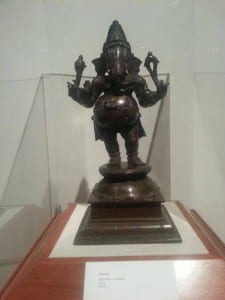Before coming to SMU, I had never been to the Crow Collection. Since the beginning of the semester, I have gone there four times, and each time I learn something new about the objects in the collection, especially the ones from India. I had the pleasure last Thursday of going to a lecture by Dr. Steven Lindquist, who is a professor at SMU, about art specifically relating to Hinduism.
Lindquist structured his lecture into two halves of Indian History: the first era of Indian civilization and the revival of Indian civilization. He began by talking about what we often think of when we hear “Hindu art” such as devotional objects and temple carvings, then broadened that definition to the mass produced poster and comic book art that represent the many myths within Hinduism. This reminded me of the comic book of the Ramayana I used to read as a child, and I thought it was interesting to talk about that kind of art as it provides another look at the role that Hindu art plays in modern Indian lives.
I found that a lot of the information that we had learned in the beginning of the semester about the Indus Valley Civilization and the Vedic period was well supplemented by the content of the lecture. Lindquist was very good about presenting the interpretations of art found in the Indus Valley Civilization as theories rather than facts, and that it may not necessarily be “Hindu”. He also described in detail how the nomadic lifestyle during the Vedic period contributed to a lack of art from that time, something that made sense but I hadn’t thought much about as I wasn’t necessarily focused on an art perspective when I first learned about it.
In the next section, Lindquist explained to us the Four Aims of Human Life, Dharma, Artha, Kama, and Moksha, and how they were portrayed through mythology and art. I had known about some of the gods in Hinduism, but I didn’t realize how their stories were supposed to teach certain morals. It reminded me of the representations of the seven sins and virtues from Christianity, the difference being the devotional use of art by Hindus. These gods and myths still influence Indian artists today: Lindquist showed us an example of a mural of Shiva outside of a city, and images of Vishnu’s avatars are extremely popular. Another characteristic of Hindu art is the emphasis on the counterparts to the Gods. Shiva and Vishnu are very well known, but they both have their wives, Parvati and Lakshmi respectively, who have their own images and incarnations attached to them. A good amount of the art represents the men and women together, indicating that they complete each other rather than a male-centric view of the man possessing his wife.
I had made a comment to my father about how I wished that our class would talk a little bit more about the mythology of Hinduism, and he said that it wouldn’t be possible with all of the other topics that we had covered because it’s so easy to get lost in all of the stories. I have grown up with the Ramayana and of Krishna, but learned even more about Hinduism through the lecture. I hope to explore more of the connections between Hinduism and art in the future and can now apply a new perspective to my enjoyment of Indian art.
Statue of Ganesha from the Crow Collection


